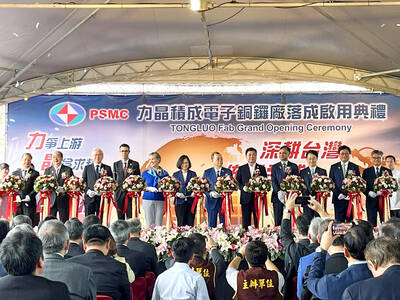TPK Holding Co Ltd (宸鴻) yesterday said its net profit almost doubled to NT$591 million (US$20.23 million) last quarter compared with a year ago as it shipped more higher-priced touchpanels for premium smartphones.
This helped the company’s full-year bottom line return to profit after two straight years of losses.
However, the growth momentum is subsiding as the smartphone industry enters its slow season this quarter, TPK chief strategist Freddie Liu (劉詩亮) said in a teleconference.
Short-term headwinds would reduce the company’s revenue by between 35 and 40 percent to between NT$20.5 billion and NT$21 billion, compared with NT$32.87 billion in the final quarter of last year, Liu said.
The company was originally expecting to beat the seasonal slowdown and post a flat first quarter, based on the assumption that its major customer’s new product might gain traction following a belated launch, Liu said.
The seasonal weakness is expected to drive factory utilization lower, with the company’s operating profit breaking even, Liu said.
Despite the hurdles, TPK will endeavor to eke out a profit this quarter through cost improvement and production efficiency, he said.
“With new products entering mass production in the second half, we believe that growth in the second half would be more significant [than the first half],” he said.
“We still believe revenue would grow this year, but it would be very challenging to keep net profit at last year’s level due to intensifying competition,” he added.
To cope with clients’ new demand, TPK plans to boost capital spending by 62 percent to NT$7.5 billion this year from NT$4.63 billion last year, by adding new manufacturing equipment.
The company will continue to invest in on nano-silver touchpanel technology in anticipation of demand for the new type of touchpanel technology, which goes with flexible OLED screens for smartphones, Liu said.
“If we can commercialize the nano-silver technology as soon as possible, it would become a major driver for the company in 2019,” he said.
Customers from the US, China and South Korea have shown strong interest in the technology, he said.
By 2020, the flexible OLED market is estimated to reach US$20 billion, Liu said.
During the final three months of last year, net profit expanded to NT$591 million from NT$296 million in the corresponding period of 2016, after TPK rejoined the supply chain for Apple Inc’s iPhone last year, company data showed.
That translated into earnings per share (EPS) of NT$1.53, up from NT$0.89 a year ago.
On a quarterly basis, net profit slumped 32 percent from NT$870 million, or EPS of NT$2.37, in the third quarter last year.
Gross margin improved to 6.7 percent last quarter from 5.5 percent a year ago. It represented a decline from 8.6 percent in the third quarter last year.
For the full year, TPK swung back to net profit of NT$2.4 billion, or EPS of NT$6.63, from the previous year’s net loss of NT$1.47 billion, or minus-NT$4.27.

BUSINESS UPDATE: The iPhone assembler said operations outlook is expected to show quarter-on-quarter and year-on-year growth for the second quarter Hon Hai Precision Industry Co (鴻海精密) yesterday reported strong growth in sales last month, potentially raising expectations for iPhone sales while artificial intelligence (AI)-related business booms. The company, which assembles the majority of Apple Inc’s smartphones, reported a 19.03 percent rise in monthly sales to NT$510.9 billion (US$15.78 billion), from NT$429.22 billion in the same period last year. On a monthly basis, sales rose 14.16 percent, it said. The company in a statement said that last month’s revenue was a record-breaking April performance. Hon Hai, known also as Foxconn Technology Group (富士康科技集團), assembles most iPhones, but the company is diversifying its business to

ARTIFICIAL INTELLIGENCE: The chipmaker last month raised its capital spending by 28 percent for this year to NT$32 billion from a previous estimate of NT$25 billion Contract chipmaker Powerchip Semiconductor Manufacturing Corp (力積電子) yesterday launched a new 12-inch fab, tapping into advanced chip-on-wafer-on-substrate (CoWoS) packaging technology to support rising demand for artificial intelligence (AI) devices. Powerchip is to offer interposers, one of three parts in CoWoS packaging technology, with shipments scheduled for the second half of this year, Powerchip chairman Frank Huang (黃崇仁) told reporters on the sidelines of a fab inauguration ceremony in the Tongluo Science Park (銅鑼科學園區) in Miaoli County yesterday. “We are working with customers to supply CoWoS-related business, utilizing part of this new fab’s capacity,” Huang said, adding that Powerchip intended to bridge

Microsoft Corp yesterday said that it would create Thailand’s first data center region to boost cloud and artificial intelligence (AI) infrastructure, promising AI training to more than 100,000 people to develop tech. Bangkok is a key economic player in Southeast Asia, but it has lagged behind Indonesia and Singapore when it comes to the tech industry. Thailand has an “incredible opportunity to build a digital-first, AI-powered future,” Microsoft chairman and chief executive officer Satya Nadella said at an event in Bangkok. Data center regions are physical locations that store computing infrastructure, allowing secure and reliable access to cloud platforms. The global embrace of AI

Qualcomm Inc, the world’s biggest seller of smartphone processors, gave an upbeat forecast for sales and profit in the current period, suggesting demand for handsets is increasing after a two-year slump. Revenue in the three months ended in June will be US$8.8 billion to US$9.6 billion, the company said in a statement Wednesday. Excluding certain items, earnings will be US$2.15 to US$2.35 a share. Analysts had projected sales of US$9.08 billion and earnings of US$2.16 a share. The outlook signals that the smartphone market has begun to bounce back, tracking with Qualcomm’s forecast that demand would gradually recover this year. The San